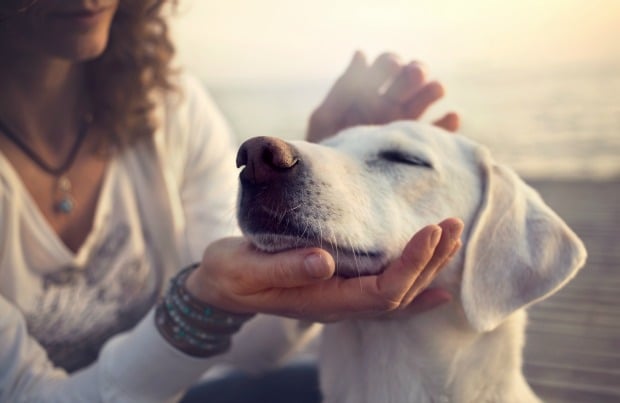There’s nothing more powerful than forging a friendship with a dog—whether it’s a rescue you’re bringing home for the first time or a random cute dog you’ve just encountered on the street. While some dogs seem to fall in love at first sight with nearly everyone they meet, other dogs require a warm-up period when meeting someone new. Getting a dog to like you is a mix of art and science—blending some Dr. Doolittle skills with a little old-fashioned treat bribery. The following tips will help you speed up the BFF process and might encourage even the most standoffish dog to like you.
Don’t Make Assumptions
First, don’t start off with the assumption that all dogs like you. Sure, it’s fun to believe that you have that special something that makes you irresistible to every dog, but the reality is that no one has that power.
Dogs are individuals shaped by their life experiences and if a dog has had negative encounters with men in baseball caps and you’re a man in a baseball cap, no amount of the “all dogs like me” attitude is going to counteract his innate fear. It’s best to go into any situation with a new dog hoping that the furry stranger wants to befriend you, rather than assuming he will like you.
Learn Canine Body Language
The single most important thing you can do to get nearly every dog to like you is to learn to speak dog. Dogs work very hard to understand what we’re saying to them and, unfortunately, we don’t always pay that same respect to them. Learning how to read canine body language is the closest you can come to actually talking with dogs. When you understand and honor what dogs are telling you with their bodies, they will be much quicker to warm up to you.
Wiggly bodies are a great indicator of willingness to interact, as well as a loose, wagging tail (keep in mind, however, that a wag can have different meanings based on the position and pace of the wag). Dogs display a number of subtle postures called “calming signals” that indicate emotional states, including stress and discomfort. These behaviors can be fleeting, but once you know what to look for you’ll be speaking dog like a pro. A dog that yawns when meeting someone new, or continuously licks his lips, might be trying to convey that he’s stressed. A person who understands these subtle signals can react accordingly and give the dog a chance to get comfortable before pursuing friendship.
Watch Your Body Language
Body language is a two-way street. When wooing a dog, you need to pay attention to your body language as well as his. Rather than looming over an unfamiliar dog you’re trying to befriend, try squatting down and facing slightly away from the dog. Don’t stare at him with direct eye contact—instead try watching him from the corner of your eye as he approaches, allowing him to do so at his own pace. If he opts to keep his distance, or sniffs at you and immediately backs up, don’t try to pet him. He’s telling you very clearly that he’s not quite sure about you and he needs more time to assess. If you want to win him over, let him set the pace for the rest of the interaction.
Follow the Three-Second Rule
It may come as a surprise, but not every dog likes to be pet in every situation. Even the most contact-driven dogs might shake off petting at the vet office or grooming salon when stress is high. Not only is the desire for petting situational, the type of petting a dog appreciates can vary as well. Few dogs enjoy a thumping pat on the head, but many of us don’t realize it.
To discover if a dog truly appreciates the way you’re touching him, try using the three-second rule. Start off with a shoulder massage, continue for three seconds and then stop doing it. If the dog leans into you or solicits more petting in an obvious way, like reaching for your hand with his paw, you were doing something right! If the dog doesn’t ask for more, or walks away from you, either he’s not in the right frame of mind for touch at that moment or he didn’t appreciate the way you were doing it. Let the dog do his own thing for a bit and wait to see if he comes in close to you again. If he maintains a buffer of distance from you, then he’s just not that into being pet at that moment—and that’s totally okay.
Remember, Treats Make Friends
It’s absolutely fine to “sweeten the pot” with treats when trying to cement a dog friendship. If the dog is giving you obvious signals that he digs you, treats will make you seem that much more fantastic. If the dog seems reticent to interact with you, treats might help him to warm up to you a little quicker.
The trick with a shy dog is to toss the treat to him rather than making him collect it from your hand, because his uncertainty about you might short-circuit his desire for the treat. Some dogs will refuse treats when in a stressful situation, so if you offer a goody and the dog turns you down, make a mental note to proceed slowly (or make a mental note to invest in a meatier and more delicious treat).
Bonus Tip: Don’t Pick up the Little Dogs
It’s hard to resist picking up a small dog for some extra-close loving, but most little dogs don’t appreciate close-contact handling by strangers, as it can be scary and uncomfortable for them. The same rules apply for petite pups as with large dogs—let the dog set the pace for the interaction, understand what he’s saying with his body, watch your own body language and honor his need for space if he asks for it.
Image: FCSCAFEINE via Shutterstock

Victoria Schade is a dog trainer, author & speaker who has contributed to The Washington Post, Martha Stewart, and other publications.
Share:









